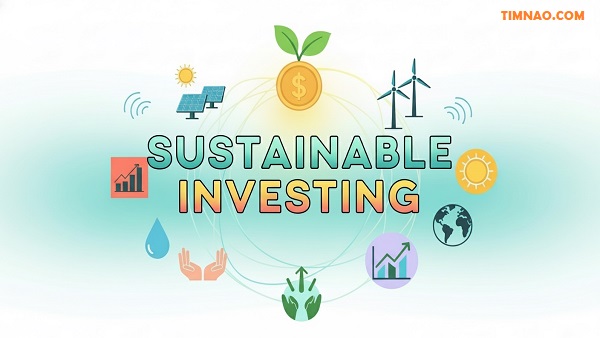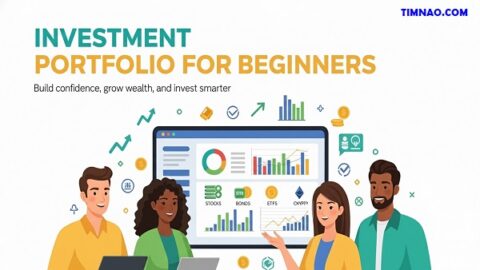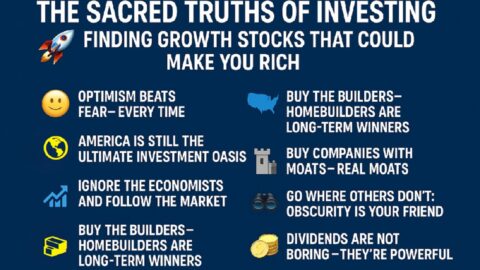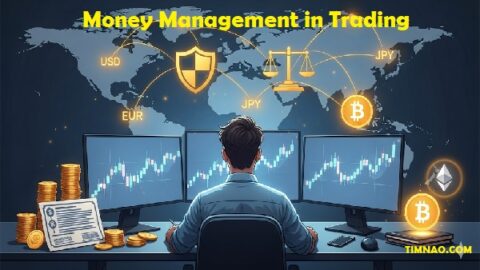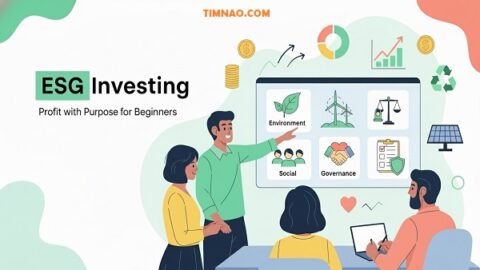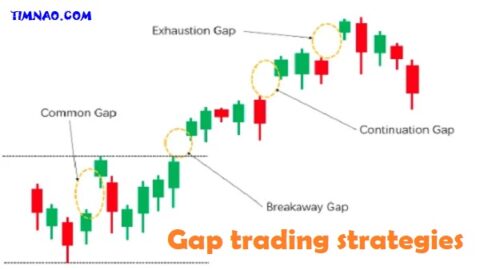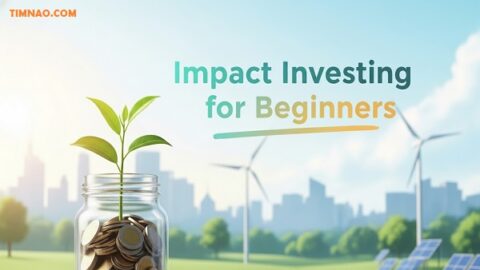Sustainable Investing Made Powerful: Profit With Purpose, Starting Today 🌱⚡
Sustainable investing puts your money to work in companies solving real problems—cutting energy waste, strengthening supply chains, protecting data, and building the low-carbon systems the world needs. Instead of treating ethics and returns as a trade-off, this approach aims to combine long-term performance with practical progress you can feel good about. If you’re new to the topic, think of it as investing with a sharper risk lens and a clearer purpose, not a separate or exotic asset class.
You’ll also see the terms ESG investing and impact investing used throughout this guide. ESG is the way we judge how well a business manages the issues that can move markets—emissions, labor safety, board independence, product safety, and more. Impact focuses on measurable outcomes: cleaner power, healthier buildings, affordable housing, resilient water systems. Together, they help you avoid greenwashing, capture durable growth trends, and build a portfolio that matches your goals.
In the next sections, you’ll get a plain-English playbook to start today: a 60-minute portfolio setup, a five-step greenwashing detector, and 15 money-making ideas ranging from low-cost ESG index funds to green bonds, infrastructure income, and beginner-friendly ways to engage your shareholder voice. You’ll see examples for different budgets, a week-long action plan, and simple metrics to track what matters. Let’s dive in and turn good intentions into a strategy that compounds.
Table of Contents
- 🌍 The Big Idea: Why Sustainable Investing Can Be a Smart Money Move
- 🧭 What ESG, Impact & “Sustainable” Really Mean (and Don’t)
- 💼 15 Practical Ways to Make Money Sustainably
- 🕵️ Greenwashing Detector: How to Pick the Right Fund
- ⚙️ A 60-Minute Blueprint to Build Your First Portfolio
- 📊 Measure What Matters: Goals, Metrics & Tools
- 🌐 Real-World Examples for Different Budgets
- 🧩 Advanced Moves Once You’ve Mastered the Basics
- 🧠 Myths, Traps & FAQs
- 🗓️ Your 7-Day Action Plan
- ✅ Key Lessons & Takeaways
🌍 The Big Idea: Why Sustainable Investing Can Be a Smart Money Move
What it really means for beginners
Sustainable investing is simply investing with your eyes open. You still care about price, growth, and quality—now you also check how a company uses energy and materials, treats people, protects data, and makes long-term decisions. Think of it as adding a sharper risk lens and a clearer purpose to the investing playbook you already know. For beginners, the big shift is practical: keep diversification, then tilt your portfolio toward companies built for a cleaner, more resilient, better-governed economy.
You don’t need to change everything at once. Start with broad, low-cost funds that integrate environmental, social, and governance factors, then add small, targeted “tilts” to themes you believe in. As your confidence grows, you can layer in solutions—energy efficiency, water stewardship, circular materials, grid infrastructure—without turning your portfolio into a single-theme bet.
How it improves risk-adjusted returns (efficiency, resilience, governance)
If you’ve ever cut a home power bill by sealing leaks or switching to LEDs, you’ve seen how small improvements compound. Businesses are no different. Lower energy intensity, safer operations, and smarter sourcing all show up as lower costs and fewer nasty surprises. Avoided fines, fewer product recalls, and stronger brand trust won’t scream from a headline, but they quietly protect margins and cash flow.
Here are the most reliable drivers you’ll meet in sustainable investing:
- Cost discipline: Efficiency upgrades—motors, HVAC, process heat, data-center cooling—pay back and keep paying.
- Durable revenue: Safer products and credible sustainability claims win contracts and loyal customers, improving pricing power.
- Cheaper capital: Clear transition plans and transparent risk management reduce lenders’ and investors’ fear, often lowering borrowing costs.
- Resilience: Diversified suppliers, robust safety programs, and climate planning help companies bounce back quickly from shocks.
- Governance quality: Boards with expertise, aligned incentives, and strong controls spot risks earlier and allocate capital better.
In portfolio terms, sustainable investing is “downside defense + upside optionality.” Better operations and governance can reduce tail-risk; meanwhile, the world is spending heavily on cleaner power, efficient buildings, electrified transport, and water infrastructure. Firms that provide the “picks and shovels” to these transitions tap steady, policy-supported demand that can persist across cycles.
A key advantage: you don’t have to abandon broad exposure. You can hold a marketlike core while tilting toward lower-emission leaders or companies with rising “green revenue” shares. That keeps total risk near the market while nudging the portfolio toward long-horizon trends.
Market momentum & what’s changed recently
Three developments have made sustainable investing far more practical for everyday investors:
- Better disclosure and standards. Companies increasingly report decision-useful metrics—carbon intensity, water usage, safety, and governance—under standards like the ISSB and industry-specific materiality maps from SASB. Better inputs raise the quality of every investment process.
- Broader product menus at lower cost. Most brokerages now offer ESG index funds, targeted thematic ETFs, and green/social/sustainability-linked bond funds. You can screen and compare options using Morningstar Sustainable Investing and MSCI ESG Ratings without leaving your browser.
- Real-economy tailwinds. Public and private capital continue to flood into clean power, grid upgrades, building retrofits, and water systems. As technology improves and costs fall, adoption spreads from early adopters to the mainstream. That creates secular demand for companies solving real problems.
For beginners, the takeaway is simple: you have better data, more funds to choose from, and more ways to match your portfolio to durable economic trends—without overpaying or overconcentrating. Start wide, tilt thoughtfully, and let compounding do the heavy lifting.
🧭 What ESG, Impact & “Sustainable” Really Mean (and Don’t)
ESG as a risk lens (not a moral badge)
ESG stands for Environmental, Social, and Governance. It isn’t a medal of virtue—it’s a risk-and-quality checklist for how a company operates. The “E” looks at resource use and pollution; the “S” covers people, customers, and supply chains; the “G” assesses leadership, incentives, and controls. Regardless of your politics, waste, safety failures, data breaches, and weak boards can hit earnings and reputation.
Use ESG like you compare two similar companies:
- Which one uses less energy per dollar of revenue?
- Which has fewer product recalls and better retention?
- Which has an independent board that challenges management on capital allocation?
A few ground rules keep the process practical:
- Materiality first. Focus on the issues that can realistically move cash flows in a given industry (data privacy for software, water stress for beverages, tailings for mining).
- Scores are signals, not truth. Providers weigh factors differently, so ratings can diverge. Use them as starting points, then read the fund factsheet or company report.
- Avoid box-ticking. A glossy PDF isn’t the same as improved operations. Look for performance trends—rising energy productivity, declining injury rates, stronger supplier audits.
- Governance is the hinge. Board independence, audit quality, and sensible incentives turn intentions into execution.
Day-to-day for beginners:
- Choose a broad ESG index fund as your core equity holding.
- Match it with a bond fund that integrates material ESG risks on the fixed-income side.
- Skim top holdings and the manager’s stewardship/voting report annually. If the behavior matches your expectations, stay; if not, switch.
Helpful cross-checks: Morningstar Sustainable Investing for fund profiles and Fossil Free Funds for holdings transparency. Treat these as maps, not the territory.
Impact investing for measurable outcomes
If ESG is the lens, impact investing is the lens plus a measuring stick. You’re not only asking “Is this company run well?”—you’re also asking “What measurable good comes from this capital?” In public markets, impact shows up as thematic funds (clean energy, water, circular economy) and labeled bonds financing specific projects. In private markets, it can be direct investments in renewable assets, energy-efficiency retrofits, or inclusive finance.
What counts as “measurable”? Seek outputs and outcomes that are concrete and comparable:
- Environmental: megawatt-hours of clean power produced, tons of CO₂e avoided, liters of water treated or saved.
- Social: affordable homes financed, small businesses funded, patients served, accidents prevented.
- Governance/market integrity: better shareholder protections, improved disclosure, tighter anti-corruption controls.
You’ll see frameworks like the UN SDGs for thematic alignment, ISSB/SASB for financially material topics, and GIIN/IRIS+ for standardized impact metrics. As a beginner, you don’t need to memorize them—simply use them to sanity-check whether a fund measures what it claims.
A simple way to start without taking on too much risk:
- Pick one theme that matters to you—water stewardship or building efficiency are great beginner options.
- Allocate a small satellite (5–10% of equities) to a diversified ETF or mutual fund in that theme.
- Favor funds with plain-English impact reports that explain metrics and methods.
- Accept the volatility. Thematic funds can be concentrated; keep your core diversified so the satellite doesn’t dominate your risk.
Remember, engagement is impact too. Even broad funds can file or support shareholder proposals that push for safer chemicals, better climate disclosure, or independent chairs. Use your broker’s proxy-voting portal to express preferences—collective action from ordinary investors is how many governance improvements happen.
“Sustainable” investing in practice (and what it isn’t)
Sustainable investing is the portfolio-level application of everything above: you intentionally favor businesses prepared for long-term realities—cleaner energy, resilient supply chains, safer products, fair workplaces, strong governance—while still aiming for competitive returns. It’s not a separate asset class; it’s a way to decide what you own across stocks, bonds, real estate, and infrastructure.
What sustainable is not: it’s not a moral purity test or a guarantee of impact just because a label says so. It doesn’t mean excluding entire sectors forever or ignoring valuation. It’s also not static—as technologies, regulations, and customer preferences evolve, a sustainable portfolio should adapt. And it’s not only about climate; social and governance issues often drive near-term financial outcomes.
To keep “sustainable” concrete, evaluate how profits are earned:
- Are energy and water intensity falling year after year?
- Do products last longer and carry lower safety risk?
- Are suppliers audited and executives incentivized for multi-year results?
A useful three-step pattern is Avoid, Improve, Solve:
- Avoid the worst risk exposures—unchecked safety issues, opaque governance, chronic controversies.
- Improve by tilting toward companies with rising efficiency and credible transition plans.
- Solve by allocating a sleeve to solution providers—efficiency hardware, grid software, water treatment, circular materials—where real-economy demand is compounding.
Beginner-friendly moves you can make this month:
- Core + tilts. Hold a global ESG-integrated equity index and a core bond fund that considers material risks. Add one sustainability theme you understand.
- Green bonds for ballast. Consider a green bond fund aligned with the ICMA Green Bond Principles to finance building retrofits, clean transport, or grid upgrades.
- Infrastructure for income. A listed infrastructure fund (grids, rail, water utilities) can add inflation sensitivity while funding assets the transition requires.
- Make stewardship real. Read your manager’s engagement report and use your brokerage’s proxy tools; stewardship turns “sustainable” from a label into accountability.
- Quarterly sanity check. Revisit top holdings: “Do these businesses reduce risk and align with long-term trends—or am I just buying a green name?”
Where “sustainable” shows up across asset classes:
- Equities: broad ESG-integrated core plus best-in-class or thematic satellites (energy efficiency, water, circular economy, cybersecurity).
- Bonds: green/social/sustainability-linked bonds via diversified funds; municipal green bonds for climate-resilient local infrastructure (check tax considerations in your jurisdiction).
- Real estate: REITs prioritizing energy retrofits and recognized certifications (LEED/BREEAM) to lower operating costs and vacancy risk.
- Listed infrastructure: grid operators, water utilities, rail, and cell towers—often with inflation-linked cash flows and tangible roles in the transition.
Avoid these beginner pitfalls:
- Paying any price for a great story. Valuation still matters; a stretched multiple can unwind gains fast.
- Overconcentration. Cap thematic satellites to ~20–30% of equities until your experience grows.
- Set-and-forget diligence. Re-read factsheets at least annually; strategies and holdings evolve.
- Ignoring governance. Strong governance translates aspirations into execution; weak governance undermines it all.
A quick stock-picking checklist (if you buy individual names):
- Durability: consistent free cash flow, moderate leverage.
- Operational trends: multi-year declines in energy intensity and injury rates; rising supplier audit coverage; credible targets.
- Pricing power: customer willingness to pay for safer, more efficient, lower-footprint products.
- Governance quality: independent leadership, sensible pay, solid audit trail.
- Position sizing: start small, add on execution, diversify across industries.
Common myths to drop early
Clearing out a few misconceptions will make your journey smoother:
“ESG always costs returns.” Results vary by period and strategy. ESG is primarily risk-aware quality control; returns still come from valuation, growth, and execution.
“Sustainable investing equals clean energy stocks.” The real economy needs grids, efficient buildings, water systems, materials innovation, and cybersecurity. Your portfolio can reflect that breadth while staying diversified.
“Only the wealthy can do this.” Low-cost ESG index funds and $0-commission ETFs are standard on major platforms. Automate small monthly contributions and let compounding work.
“It’s just politics.” Waste, safety failures, and weak governance hit earnings regardless of your views. Operational discipline is financially material.
“Ratings are the final word.” Treat scores as inputs. Verify holdings, stewardship behavior, and fees; if the fund walks its talk, keep it—if not, switch.
“Greenwashing makes it pointless.” Marketing sometimes runs ahead of reality. That’s why you use a simple checklist: clear strategy, aligned holdings, measurable metrics, visible stewardship, reasonable fees, third-party cross-checks.
💼 15 Practical Ways to Make Money Sustainably
You don’t have to rebuild your entire portfolio to invest with purpose. A better approach is to keep a diversified core and add clear, well-defined sleeves that earn money by cutting risk or tapping long-term demand—energy efficiency, resilient infrastructure, clean power, water systems, and strong governance. Below are 15 practical, beginner-friendly paths. Each one explains what it is, how it makes money, how to pick funds or assets, and what to watch out for. Use them like a menu: start with one or two, then grow as your confidence does.
1) Core ESG Index Funds (Set-and-Forget)
What it is: Low-fee stock market trackers that integrate environmental, social, and governance factors while maintaining broad diversification.
How it makes money: Market-like returns over time with a tilt away from companies carrying outsized operational, legal, or reputational risks. Lower costs help compounding.
How to pick: Look for global exposure, simple rules, and tiny expense ratios on platforms like Vanguard, Schwab, or Fidelity. Compare sustainability profiles on Morningstar.
Watch-outs: Don’t expect perfection or dramatic outperformance every year. The win here is broad exposure + better risk control at low cost.
2) Best-in-Class Active Equity
What it is: Active managers overweight leaders within each sector (not just “green” sectors).
How it makes money: By owning companies that run safer, leaner, better-governed operations—potentially compounding quality advantages through cycles.
How to pick: Read the strategy summary and stewardship report: what do they exclude, what do they tilt toward, and how do they vote? Favor firms that publish engagement results, not just policies.
Watch-outs: Fees must match the manager’s edge. If voting and engagement are weak—or holdings don’t match the pitch—look elsewhere.
3) Thematic ETFs (Targeted Growth)
What it is: Funds focused on a single theme: clean energy, energy efficiency, battery value chains, water stewardship, circular materials, or cybersecurity.
How it makes money: Concentrated exposure to long-term adoption curves. When a theme accelerates, returns can stack quickly.
How to pick: Scan holdings and index rules on issuers like iShares, SPDR, VanEck, or Invesco. Favor diversified baskets, clear inclusion criteria, and reasonable fees.
Watch-outs: Higher volatility; avoid making a theme more than 10–20% of your equities until you gain experience.
4) Dividend + Quality With a Sustainability Tilt
What it is: Equity strategies that target profitable, cash-generative companies with strong balance sheets and better-than-peer sustainability practices.
How it makes money: Through dividends + quality characteristics that can dampen drawdowns, plus operational discipline that supports margins.
How to pick: Seek funds that blend dividend yield with quality screens (return on capital, stable earnings) and integrate material ESG risks.
Watch-outs: High dividend yield alone isn’t a strategy; you want durability and a history of maintaining or growing payouts.
5) Green, Social & Sustainability-Linked Bonds (GSS+)
What it is: Bonds that finance specific projects—clean transit, building retrofits, water infrastructure—or tie coupons to sustainability KPIs.
How it makes money: Bond income plus the diversification benefits of fixed income. Labeled bonds often have robust reporting, making the “use of proceeds” clear.
How to pick: Choose diversified funds with transparent impact reports and alignment to the ICMA Principles.
Watch-outs: Don’t pay up for a label. Compare yield, duration, credit quality, and fees against vanilla bond funds.
6) Green Municipal Bonds (Where Available)
What it is: Local-government bonds funding climate-resilient projects—storm-water systems, coastal protection, grid hardening, and transit.
How it makes money: Interest income; in certain jurisdictions, munis may have tax advantages.
How to pick: Favor well-researched muni funds with project-level disclosure. Look for diversified state/sector exposure and strong credit work.
Watch-outs: Credit is local. Check concentration risk (one city or authority dominating the portfolio). When in doubt, use broad muni funds.
7) Climate-Aware Investment-Grade Credit
What it is: Corporate bond funds that underweight issuers with high transition risk (e.g., heavy coal exposure) and overweight those with credible plans.
How it makes money: Income from higher-quality credit plus modest risk reduction from avoiding likely laggards.
How to pick: Prefer managers who publish sector heat maps, scenario analysis, and clear rationales for over/underweights.
Watch-outs: Credit still carries interest-rate and spread risk. Keep duration in line with your time horizon.
8) Listed Infrastructure (Inflation-Sensitive Income)
What it is: Publicly listed owners/operators of essential assets—power grids, water utilities, rail, toll roads, cell towers.
How it makes money: Many contracts are inflation-linked; cash flows can be steady, supporting dividends.
How to pick: Look for funds with diversified subsectors and regions, clear leverage limits, and climate-risk assessments.
Watch-outs: Rate sensitivity is real. When rates rise fast, infrastructure can soften; stay diversified and patient.
9) Yieldcos & Renewable Infrastructure Income
What it is: Listed vehicles that hold operating wind/solar/storage assets under long-term contracts.
How it makes money: Cash distributions from contracted power sales; potential growth as more projects drop into the portfolio.
How to pick: Examine contract duration, counterparties, debt maturity ladders, and payout ratios.
Watch-outs: Sensitive to interest rates and policy changes. Don’t chase yield—focus on balance sheet strength and contract quality.
10) Green Real Estate (REITs & Retrofits)
What it is: Real-estate investment trusts prioritizing energy-efficient buildings, certifications (LEED/BREEAM), and retrofit programs.
How it makes money: Lower operating costs, better occupancy, and resilience to upcoming building-performance rules can support higher net operating income over time.
How to pick: Favor REITs with clear energy intensity targets, retrofit pipelines, and transparent tenant engagement.
Watch-outs: Real estate is cyclical and rate-sensitive. Use a sector-diversified REIT fund if you’re new.
11) Carbon-Efficient Factor Funds
What it is: Rules-based strategies that tilt toward companies with lower emissions per dollar of revenue (or growing “green revenue”) while keeping market-like risk.
How it makes money: Market beta plus a systematic tilt toward firms managing transition risks and opportunities better than peers.
How to pick: Read the index methodology: Is the carbon measure intensity or absolute? Is there a cap on tracking error versus the parent index?
Watch-outs: These are not pure “exclusion” funds; they aim to stay close to the market. Expect performance similar to broad indexes with small differences over time.
12) Direct Indexing With Exclusions/Tilts
What it is: You own the individual stocks of an index and customize it—exclude certain industries, overweight leaders, and harvest tax losses.
How it makes money: Market-like returns, potential tax alpha from loss harvesting, and customization aligned to your sustainability thesis.
How to pick: Many brokers now offer it; compare minimums, fees, and tax features at Schwab, Fidelity, and others.
Watch-outs: Requires some oversight. Keep custom tilts modest to avoid accidental concentration and higher tracking error.
13) Mission-Aligned Cash & Banking
What it is: Parking emergency funds at banks or credit unions with transparent lending practices.
How it makes money: Savings interest while supporting institutions that avoid financing the riskiest fossil or extraction projects.
How to pick: Search options via Bank.Green or your local credit-union directory. Confirm FDIC/NCUA coverage and current APYs.
Watch-outs: Don’t sacrifice safety. Insurance limits and liquidity come first for cash.
14) Community & CDFI Notes
What it is: Notes that channel capital to Community Development Financial Institutions, which lend to small businesses, affordable housing, and underserved communities.
How it makes money: Modest, steady interest in exchange for mission-aligned lending.
How to pick: Look at transparent platforms like CNote. Check terms, liquidity, and historical repayment performance.
Watch-outs: Yields are typically lower than corporate bonds; treat this as a stability + impact sleeve, not your core growth engine.
15) Climate Tech & Impact Private Markets (Advanced)
What it is: Private equity/credit or venture capital aimed at grid software, building electrification, precision agriculture, circular materials, and more. Usually for accredited investors who can handle illiquidity.
How it makes money: If solutions scale, returns can be significant. Private credit may earn attractive yields financing upgrades with tangible paybacks (e.g., heat-pump retrofits).
How to pick: Diversified, experienced managers with clear governance, independent mark-to-model controls, and third-party verification of impact.
Watch-outs: Illiquidity, selection risk, and long hold periods. Keep allocation small and diversify across funds and vintages.
A Simple Allocation Template You Can Copy
Use this if you want a concrete starting point. Adjust the percentages to your risk tolerance:
- 60–80% Core: One global ESG equity index + one ESG-integrated bond fund.
- 10–25% Income & Stability: Mix of green bonds, climate-aware credit, and listed infrastructure.
- 5–20% Thematic Growth: 1–2 themes you understand (e.g., energy efficiency, water, circular materials). Keep any single theme ≤10% of equities.
- 0–5% Community/Impact Cash: Mission-aligned banking or CDFI notes for steady yield and feel-good alignment.
- 0–10% Advanced: Yieldcos/REITs or small private markets sleeve if eligible.
Rebalance once or twice per year. If any sleeve drifts 5–10 percentage points from target, bring it back. Reinvest dividends automatically so compounding keeps working while you’re busy living your life.
A 10-Minute “Greenwashing” Checklist for Any Fund
Before you buy, walk through these quick checks:
- Name vs. Holdings: Do the top 10 holdings actually fit the theme?
- Process Clarity: Is the approach exclusions, best-in-class, or thematic—with real rules?
- Metrics: Are there carbon/controversy metrics and plain-English impact or stewardship reports?
- Voting: Has the manager supported meaningful shareholder proposals or disclosed engagement outcomes?
- Cost: Is the expense ratio competitive for what you’re getting?
- Fit: Does it play a clear role in your portfolio (core, income, theme) without creating overlap?
Where to Research—Fast
- Fund profiles & sustainability: Morningstar Sustainable Investing
- Issuer-level ESG snapshots: MSCI ESG Ratings
- Fossil exposure checks: Fossil Free Funds
- Green bond standards: ICMA Principles
- Broker platforms: Vanguard, Schwab, Fidelity
- Community finance: CNote, Bank.Green
Quick Mistakes to Avoid (So You Stay Confident)
- Overconcentration: One hot theme shouldn’t dominate your results.
- Fee creep: Fancy names don’t justify high costs; compare peers.
- Label chasing: Buy strategy, not slogans.
- Ignoring bonds: Green and climate-aware credit can steady returns when stocks wobble.
- Neglecting governance: If incentives and oversight are weak, good intentions won’t matter.
A Friendly Way to Get Started This Week
- Today (10 min): Write your “why,” pick one ESG core equity and one ESG bond fund, and enable dividend reinvestment.
- Tomorrow (15 min): Choose one theme (efficiency or water is a great start) and cap it at 5–10% of equities.
- This weekend (20 min): Add either green bonds or listed infrastructure for stability and income.
- Next week (15 min): Open a mission-aligned savings account for your emergency fund and set a monthly auto-transfer.
- Month’s end (10 min): Review top 10 holdings and your manager’s stewardship page; if it aligns with your values and thesis, keep going.
You don’t have to do everything. You just have to start, stay diversified, and keep costs low. As your understanding grows, you can refine the sleeves, rotate themes thoughtfully, and even try direct indexing for custom tilts. The goal is not perfection; it’s progress that compounds.
🕵️ Greenwashing Detector: How to Pick the Right Fund
The 10-minute triage (start here)
Before you deep-dive into PDFs, run this quick filter. It saves time and catches most pretenders.
- Name vs. top holdings. Open the fund page and scan the top 10. Do they actually fit the theme? A “clean infrastructure” fund stuffed with unrelated mega-cap tech is a red flag.
- Process in one sentence. The factsheet should state how the fund invests: exclusions, best-in-class selection, or a thematic index with rules. If it only says “we consider ESG,” move on.
- Stewardship receipts. Check for proxy voting records, engagement case studies, or a stewardship report. Policies without outcomes ≠ stewardship.
- Metrics that matter. Look for a small set of numbers you can track: carbon intensity trend, % green revenue, controversies.
- Fee and fit. Is the expense ratio competitive for the category? Does the fund fill a distinct role in your portfolio (core, income, or theme) without duplicate exposure?
If a fund fails two or more of these, you’ve probably dodged greenwashing.
Read the documents like a pro (without getting lost)
You don’t need a CFA to decode a fund. Focus on three places:
- Factsheet (1–2 pages): Objective, index or process, top 10 holdings, sector/region weights, expense ratio, tracking error, and basic sustainability metrics.
- Prospectus/Key Information Document: How the strategy is implemented, screens, risks, and any use of derivatives. This is where you catch style drift.
- Stewardship/impact report: Voting record highlights, engagement outcomes (not just activity), and year-over-year changes in metrics.
Tip: read for verbs and numbers. “We engaged 200 times” is activity; “We secured supplier audits across 85% of a portfolio company’s spend” is an outcome.
Decode holdings and revenue (does the money match the story?)
A fund’s story only matters if cash flows support it. When you scan holdings:
- Business model fit: How does each top holding actually earn money? If the theme is energy efficiency, are you seeing HVAC leaders, motor manufacturers, building controls, and grid software—or generic tech?
- Green revenue share: Does the manager disclose the % of revenue tied to solutions (e.g., efficiency, clean power, water, circularity)? Rising green revenue is a useful sign.
- Transition exposure: For diversified funds, are high emitters improving? Evidence: capex toward lower-carbon lines, intensity reduction targets, or product mix shifts.
- Quality and valuation: Theme ≠ excuse. Free cash flow, sensible leverage, and reasonable valuations still matter.
A quick trick: read two annual reports for the same fund (current and last year). Are holdings converging toward the stated strategy—or drifting?
Understand sustainability metrics (only the ones that help you)
You’ll see a blizzard of data. Keep it to a simple dashboard:
- Carbon intensity: Emissions per revenue—useful for comparing firms across sizes. Track the direction (falling is good).
- Scope 1/2/3 basics: Scope 1 (on-site), Scope 2 (purchased energy), Scope 3 (supply chain & use-phase). You don’t need perfect numbers; you need a manager who knows where the big risks sit.
- Controversies trend: Fewer, smaller incidents over time is a win.
- Physical vs. transition risk: Is the portfolio exposed to heat, flood, or wildfire risk—and to policy or demand shifts?
- Active ownership: Count wins, not meetings—policy changes, target adoptions, board refreshes.
If a fund throws 40 metrics at you but can’t show progress on 4–6 material ones, it’s likely optics.
Red flags and deal-breakers (walk away quickly)
- Vague language: “We consider ESG” with no specifics.
- Contradictory holdings: Top positions at odds with the fund name.
- Index hugging with high fees: Active price for passive behavior.
- Derivatives hiding exposure: Swaps that re-add excluded sectors without disclosure.
- Style drift: A thematic fund morphs into generic growth to chase performance.
- One-time “impact” stories: Cherry-picked anecdotes with no measurement framework.
Mini case study: choosing between two look-alikes
- Fund A shows a rules-based index for water stewardship, lists % revenue from water tech across top 10, publishes city-level project case studies, and charges a fair fee.
- Fund B says “we consider water risk,” owns several unrelated tech giants, offers boilerplate reports, and charges more.
Pick Fund A. It aligns holdings, metrics, and price with its promise.
A streamlined checklist (copy/paste)
- Name ↔ Holdings fit
- Clear process and screens
- Top 10 holdings analysis (business model & green revenue)
- 4–6 metrics with year-over-year progress
- Stewardship outcomes (not just policies)
- Competitive fee and a clear role in your allocation
⚙️ A 60-Minute Blueprint to Build Your First Portfolio
Minute 0–10: Clarify purpose, risk, and cash needs
Write one sentence: “I invest to __ (goal) __ while supporting __ (themes) __ and avoiding __ (red lines) __.”
Then set guardrails:
- Horizon: When will you need this money?
- Risk budget: How did you react in the last big drawdown?
- Savings rate: What can you automate monthly without stress?
- Cash buffer: 3–6 months of expenses in an insured, liquid account—before investing.
Minute 10–20: Pick your core (keep it boring and brilliant)
Choose one global ESG equity index and one ESG-integrated bond fund. This is 60–80% of your portfolio.
- What to look for (equities): global coverage, low fees, clear ESG integration, reasonable tracking error.
- What to look for (bonds): diversified, investment-grade, transparent process for material ESG risks, and interest-rate exposure you can live with.
Set both to reinvest dividends. Your core is the engine of compounding.
Minute 20–30: Add 1–3 satellites (keep them small)
Pick themes that connect to your thesis and that you understand:
- Efficiency & electrification: motors, building controls, heat pumps, grid software.
- Water systems: treatment, leakage detection, metering, reuse.
- Circular materials: recycling tech, bio-based inputs, extended product life.
- Resilient infrastructure: grids, rail, water utilities, data centers.
Cap each satellite at ≤10% of equities and satellites in total at ≤20–30%. The idea is targeted upside without hijacking risk.
Minute 30–40: Decide weights and automation
Use one of these rules of thumb for equity/bond split:
- Aggressive: 80/20
- Balanced: 60/40
- Conservative: 40/60
Or use 120 minus age as a starting point for equity %. Then:
- Automate contributions on payday.
- Turn on dividend reinvestment for all funds.
- Set rebalancing bands: If a sleeve drifts ±5–10 percentage points from target, bring it back.
Minute 40–50: Place assets in the right accounts (if available)
If you have account choices:
- Tax-advantaged accounts: Good for bond funds and higher turnover strategies.
- Taxable accounts: Favor equity index funds with low turnover.
- Direct indexing (optional): Custom exclusions and tax-loss harvesting as your balance grows.
Keep a simple note of where each sleeve lives. Asset location can add quiet return over time.
Minute 50–60: Implement, document, and relax
Make your first purchases:
- Buy the equity core and bond core to target.
- Add 1–3 satellites per your caps.
- Save a one-page Investment Policy Statement (purpose, target weights, rebalancing rule, and what will make you sell a fund).
- Set two calendar events: a quarterly 10-minute check-in and a semiannual rebalance.
You’ve just built a durable, values-aligned portfolio in an hour. The real edge now is consistency.
Optional guardrails (for calmer nights)
- Cash cushion: Keep your emergency fund separate so you never sell investments to pay bills.
- No leverage: Skip margin borrowing—compounding hates forced selling.
- Avoid timing games: Your automation beats your emotions.
- Single-theme sanity: No theme should exceed your satellite cap, even after strong performance.
Three example allocations you can copy
Starter (long horizon, learning mode)
- 70% Global ESG equity index (core)
- 20% ESG-integrated bond fund (core)
- 5% Energy-efficiency theme (satellite)
- 5% Water stewardship theme (satellite)
Balanced Builder (wants steadier ride)
- 55% Global ESG equity index (core)
- 25% ESG-integrated bond fund (core)
- 10% Listed infrastructure (income sleeve)
- 5% Green bonds (income sleeve)
- 5% Circular economy theme (satellite)
Income-Aware (closer to withdrawals)
- 40% Global ESG equity index (core)
- 35% ESG-integrated bond fund (core)
- 15% Listed infrastructure (income sleeve)
- 10% Green bonds (income sleeve)
Each plan keeps satellites modest, costs low, and rebalancing simple.
📊 Measure What Matters: Goals, Metrics & Tools
Build a scorecard you’ll actually use
Your portfolio deserves the same clarity you expect from a good product review. Create a one-page scorecard with two sections:
- Financial: return, volatility, drawdown, fees, and progress toward your savings goal.
- Sustainability: carbon intensity trend, green revenue share, controversies, and stewardship outcomes.
Update it quarterly. More often than that encourages unhelpful tinkering.
Financial metrics: keep it simple and comparable
- Annualized return: Your personal return based on actual cash flows (time-weighted if you contribute irregularly).
- Volatility & max drawdown: A quick sense of how bumpy the ride has been.
- Expense ratio (blended): Weighted average fee across your funds. Lower is usually better.
- Tracking error (core funds): If your core fund strays too far from its parent index, ask why.
Write a one-sentence explanation next to each metric in plain English. If a friend can’t understand it, simplify.
Sustainability metrics: focus on direction, not perfection
You’re not running a corporate audit, so favor metrics that connect to risk and opportunity:
- Carbon intensity (portfolio-weighted): Aim for a stable or declining trajectory relative to broad markets.
- % green revenue: Portion of revenue from solutions like efficiency, water, or clean power. Increasing shares can indicate growing demand.
- Controversies (count/severity): Track whether incidents are rising or falling.
- Engagement wins: Document tangible outcomes your fund manager achieved—policy adoption, target setting, board independence, supplier audits.
- Physical/transition risk notes: Once a year, jot down whether your holdings are more or less exposed to extreme weather or abrupt policy shifts.
Don’t get stuck chasing perfect data. You want signals that change your decisions, not dashboards that impress no one.
Your tool stack (free or low-cost)
- Fund research & sustainability views: Morningstar Sustainable Investing
- Issuer snapshots & indices: MSCI ESG Ratings
- Fossil exposure & screens: Fossil Free Funds
- Standards & materiality: ISSB/SASB
- Bond frameworks: ICMA Principles
- Broker dashboards: Vanguard, Schwab, Fidelity
Pick two sources you like and stick with them. Consistency beats source-hopping.
Build a simple dashboard (copy this layout)
Create a spreadsheet with these columns:
- Date | Portfolio value | Contribution this quarter | Equity % / Bond % | Return (YTD / 1Y / 3Y) | Volatility (1Y) | Expense ratio (blended)
- Carbon intensity (rel. to index) | Green revenue (%) | Controversies (count/severity) | Engagement wins (notes) | Actions next quarter
Color-code cells: green for on-track, yellow for watch, red for act. Keep the Actions cell to three bullet points, max.
Interpreting results (how to act without overreacting)
- If performance lags short-term but your thesis holds: rebalance and keep going. Many sustainable themes are multi-year arcs.
- If fees creep up: switch to a cheaper, similar fund. Don’t pay active prices for passive behavior.
- If sustainability metrics worsen for two periods: investigate. Has the fund changed methodology or drifted in holdings?
- If satellites dominate risk: trim back to your caps and redirect to core.
- If engagement stalls: consider managers with stronger stewardship records.
Write down your decision in one line. Future-you will thank you for the paper trail.
Your annual review (90 minutes once a year)
Once a year, zoom out:
- Goal check: Am I on track for my savings target given contributions and returns?
- Allocation sanity: Do my weights still reflect my risk capacity and time horizon?
- Fund refresh: Have any funds drifted from their mandate or raised fees?
- Metric trends: Are carbon intensity and controversies improving? Any standout engagement wins?
- One improvement: Choose one upgrade (e.g., lower fee core fund, clearer thematic, better stewardship manager).
Celebrate progress. Then set next year’s auto-contribution to nudge your plan forward.
Analytics mistakes to avoid (so you keep learning)
- Data overload: Do not track 30 metrics. Five that drive action are enough.
- Short-term scorekeeping: Monthly leaderboard thinking will wreck your discipline.
- Chasing heat: Buying last quarter’s star theme is how investors stay average.
- Ignoring total cost: Expense ratios, trading spreads, and taxes compound—quietly.
- Neglecting governance: Operational excellence dies without aligned incentives and oversight.
Your portfolio is a living system. Keep the scorecard lean, your process steady, and your expectations long-term. That’s how sustainable investing turns from an idea into results you can touch.
🌐 Real-World Examples for Different Budgets
You don’t need a huge account to start sustainable investing. What you do need is a plan that matches your budget, time horizon, and comfort with risk. The examples below are plug-and-play templates you can copy and adapt. They balance ESG investing cores with small, purposeful tilts and real-world guardrails so you can apply them today.
$100–$1,000: The Confident Starter
Goal: build the habit, keep fees tiny, learn by doing.
Simple allocation (copy this):
- 70% global ESG equity index (core)
- 20% ESG-integrated bond fund (core)
- 10% single theme you understand (water management or energy efficiency)
How to implement in 30 minutes:
- Open a low-cost brokerage at Vanguard, Schwab, or Fidelity.
- Buy one global ESG index fund and one ESG bond fund; enable dividend reinvestment.
- Add one thematic ETF (water or efficiency) and cap it at 10% of equities.
- Turn on a $25–$100 monthly auto-buy. The habit is the win.
Why this works: your core does the heavy lifting; the theme keeps you engaged. You’ll learn to read factsheets, watch top holdings, and track a tiny metrics set: return, fees, carbon intensity trend, and controversies count.
Beginner pitfalls to avoid:
- Chasing hot clean-tech tickers; stick to diversified funds.
- Over-theming; one satellite is plenty at this stage.
- Skipping a cash buffer; keep 3–6 months’ expenses outside investments.
Mini-story: Maya starts with $300. After three months of $50 auto-buys, she’s contributed $450. Her portfolio is still small, but she understands what she owns, her fees are low, and she’s seen her first quarterly rebalance nudging weights back to target. That’s momentum money can’t buy.
$5,000–$25,000: The Builder Portfolio
Goal: add income and resilience without losing the simplicity of your core.
Suggested allocation:
- 55% global ESG equity index (core)
- 20% ESG-integrated bond fund (core)
- 10% listed infrastructure (income sleeve)
- 10% green bonds (income sleeve)
- 5% one thematic ETF (efficiency or circular economy)
Upgrades that matter now:
- Income sleeves: infrastructure and green bonds can dampen drawdowns and add steady coupons.
- Tooling: use Morningstar Sustainable Investing to compare fees, holdings, and carbon metrics across similar funds.
- Stewardship check: scan your managers’ voting records (usually linked on fund pages) to ensure actions match marketing.
Practical automation:
- Auto-buy core funds every payday.
- Auto-rebalance semiannually or when drift exceeds ±5–10 percentage points.
- Keep satellites ≤ 20–30% of equities in total.
Tax and account placement (if available):
- Put bond sleeves inside tax-advantaged accounts where possible.
- Keep equity index funds in taxable accounts for lower turnover.
- Turn on specific-lot selection to harvest losses thoughtfully.
Mini-story: Quang grows from $6,500 to $12,000 over a year by auto-investing. When rates jump, his infrastructure sleeve softens but green bonds offset some volatility. He stays the course because his plan explained what to expect—before the headlines did.
$25,000–$250,000: Growth, Income & Stewardship
Goal: blend passive efficiency with selective active managers and deeper stewardship.
Suggested allocation:
- 45% global ESG equity index (core)
- 20% ESG-integrated bond fund (core)
- 10% listed infrastructure (income sleeve)
- 10% green bonds or climate-aware credit (income sleeve)
- 10% best-in-class active equity (stewardship sleeve)
- 5% green real estate (REITs & retrofits)
Why add best-in-class active now: you’re paying for research + engagement. Look for managers that publish engagement case studies and proxy votes, not just policies. If you can’t see outcomes they influenced, don’t pay active fees.
Direct indexing (optional): if your broker offers it, build a custom index with modest exclusions (e.g., thermal coal) and tilts (efficiency leaders). The payoff is control and tax-loss harvesting—but keep tracking error modest.
Risk hygiene for larger balances:
- Cap any single theme at ≤10% of equities; cap all satellites at ≤30%.
- Demand contract quality and sensible leverage from yieldcos/REITs.
- Maintain a written Investment Policy Statement and review it annually.
Mini-story: Linh and Tuan reach $80,000. They add a best-in-class active fund whose team helped push a portfolio company to adopt supplier audits. They keep the sleeve at 10% and trim the theme fund after a big run, sending proceeds back to the core. Boring? Yes. Effective? Also yes.
Beyond $250,000: Optional, With Eyes Open
For experienced or accredited investors who accept illiquidity:
- Private credit for retrofits: finance heat-pump or efficiency upgrades with measurable paybacks.
- Nature and water funds: restoration, watershed resilience, and circular materials.
- Green municipal ladders (where available): pair climate-resilient projects with potential tax advantages.
Only move here when your core process is second nature. Keep illiquid sleeves small (often ≤10%) and diversifed by manager and vintage.
A three-line checklist for every budget:
- Core first, tilts second, fees always.
- Automate contributions and reinvest distributions.
- Rebalance on schedule; write down decisions.
🧩 Advanced Moves Once You’ve Mastered the Basics
Once your portfolio runs itself, you can add precision where it pays. These moves aren’t mandatory—but they can sharpen performance, control risk, and deepen impact investing outcomes without sacrificing clarity.
Transition-Linked & KPI-Linked Credit
What it is: bonds or loans where the coupon steps up if the issuer misses sustainability KPIs (e.g., emissions intensity, safety targets).
Why it helps: the structure aligns management incentives with your thesis; missed targets compensate you with higher income.
How to use: access via diversified funds run by managers who publish KPI audits and show how they verify outcomes.
Watch-outs: confirm KPIs are material, ambitious, and independently checked. Avoid soft targets that look good but change nothing.
Nature, Water & Circular Economy Strategies
What they cover: watershed restoration, leakage detection, treatment tech, reuse systems, circular materials and waste-to-value.
Why it helps: water stress and materials efficiency are real-world bottlenecks with durable demand.
How to use: add a small equity or bond sleeve; require project-level reporting for bond funds and green-revenue shares for equities.
Watch-outs: avoid funds where “water” is mostly generic industrials; insist on a rules-based index or clear active criteria.
Hedging Without Handwaving
Covered calls: write calls on broad ESG indexes to earn option income; suits investors who can tolerate capped upside.
Protective puts: insure part of your equity sleeve; useful ahead of known cash needs.
How to size: hedge only the portion you must protect (e.g., next 12–24 months of withdrawals).
Tools: most major brokers offer options education; start with paper trading on platforms like thinkorswim.
Watch-outs: options are advanced; costs and roll discipline matter.
Tax Optimization That Actually Moves the Needle
- Asset location: hold bonds and higher-turnover strategies in tax-advantaged accounts; keep equity index funds in taxable.
- Direct indexing for tax-loss harvesting: harvest small, frequent losses while keeping market exposure.
- Donation strategy: appreciated shares to charities or donor-advised funds can offset gains while supporting causes aligned with your sustainability thesis.
Direct Engagement & Proxy Power
Why it matters: engagement turns a “sustainable” label into operational change.
Do this quarterly:
- Read your fund’s proxy voting and engagement outcomes.
- Use your broker’s tools or platforms like As You Sow to align votes with your priorities.
- Keep a 3-bullet log of wins you supported (e.g., new supplier policy, independent chair, emissions target adoption).
Portfolio Analytics, But Only the Useful Bits
- Attribution: understand what drove returns—core vs. satellites, sector tilts, currency.
- Scenario checks: simple “rates up/down 1%” and “equities −20%” drills help set expectations.
- Concentration alerts: any single name >3% or theme >10% of equities triggers a review.
International Diversification & Currency
Global exposure is part of resilience. Practical tips:
- Prefer global ESG cores to avoid home-country bias.
- Accept that currency can add noise; it usually evens out over time for long-term investors.
- If you must hedge, hedge part of developed-market exposure; keep it simple and cheap.
Behavioral Edges (quiet superpowers)
- Decide when you’ll sell—before you buy. List 2–3 conditions: broken thesis, better/cheaper alternative, or persistent governance failure.
- Use cool-off rules: no selling on headline days; no buying a theme because it’s trending.
- Keep a one-page log of changes. Future-you will make better moves with this memory.
🧠 Myths, Traps & FAQs
This section clears the fog so you can act with confidence. It mixes fast myth-busting, common traps, and straight-to-the-point answers sourced from the questions beginners ask most about ESG investing and impact investing.
Myth-busting (the quick hits)
- “ESG underperforms by design.” ESG is a process for spotting operational risk and quality. Returns still hinge on valuation, growth, and execution.
- “Sustainable investing = clean energy stocks.” The investable universe spans grids, water, buildings, materials, cybersecurity, and more.
- “It’s just politics.” Waste, safety failures, and weak boards hit cash flows regardless of politics.
- “Only wealthy investors can do this.” Low-cost ESG index funds and $0-commission ETFs are standard on major platforms.
- “Ratings are truth.” Treat scores as signals. Verify holdings, fees, and stewardship.
- “Greenwashing makes it pointless.” A simple five-step check (strategy, holdings, metrics, voting, fees) filters most pretenders.
Traps That Quietly Cost Real Money
- Paying premium fees for passive behavior. If an “active” fund hugs an index, don’t pay active prices.
- Theme bloat. Too many satellites create overlap and confusion; cap satellites at 20–30% of equities.
- Label chasing in bonds. “Green” doesn’t excuse low yield or long duration that wrecks your risk budget.
- Forgetting governance. Without aligned incentives and independent oversight, sustainability stories stall.
- Set-and-forget research. Re-read factsheets annually; strategies evolve, sometimes quietly.
FAQs (straight answers you can use)
Q: Can I build a sustainable portfolio with just two funds?
A: Yes. Pair a global ESG equity index with an ESG-integrated bond fund. Add one theme only when you’re comfortable. Simplicity beats complexity you won’t maintain.
Q: What’s the difference between ESG and impact?
A: ESG is a risk/quality lens across all industries. Impact targets measurable outcomes (clean power produced, water saved). You can own both: ESG for core stability, impact for targeted sleeves.
Q: How much should I put in themes?
A: Keep each theme ≤10% of equities and all themes ≤20–30% combined. The core does the compounding; themes add flavor.
Q: How do I avoid greenwashing?
A: Match name ↔ holdings, demand a clear process, track 4–6 metrics with year-over-year progress, review voting outcomes, and compare fees. If two of these fail, walk away.
Q: What if a fund’s sustainability score drops?
A: Investigate why. If methodology changed or one holding had a temporary issue, stay patient. If the strategy drifted, fees rose, and engagement is weak, rotate to a better fit.
Q: Are green bonds worth it?
A: Often, yes—especially inside income sleeves for diversification and project transparency. Compare yield, duration, and credit to conventional peers; don’t overpay for a label.
Q: How do I measure impact without a PhD?
A: Track three things: carbon intensity trend, % green revenue, and one engagement win per year. That’s enough to keep you honest and focused.
Q: What about cash and emergency funds?
A: Keep them safe and liquid first. If you want alignment, look at mission-oriented banks via Bank.Green—but never compromise insurance limits or access.
Q: I’m worried about volatility. What should I do?
A: Nudge your equity/bond split toward more bonds, add listed infrastructure and green bonds, and keep themes small. Automation and a cash buffer reduce the urge to panic.
Q: How do I know I’m making progress?
A: Your quarterly one-pager will tell you: are contributions steady, fees low, allocation near target, and 2–3 sustainability metrics trending the right way? If yes, you’re winning.
Q: What’s the one thing to do next?
A: Set a calendar reminder to review your top 10 holdings and stewardship pages every quarter. Small, repeatable habits beat perfect-but-rare heroics.
🗓️ Your 7-Day Action Plan
You’re one week away from a simple, confident sustainable investing setup. Keep each day short and focused. You’ll end with a working portfolio, an automation plan, and a one-page dashboard you can maintain in minutes each quarter. Throughout the week, you’ll use plain-English checklists, not jargon. Sprinkle in small wins—automated deposits, DRIP (dividend reinvestment), and a calendar reminder—to let systems do the heavy lifting.
Day 1 — Write Your One-Sentence Plan (10–20 minutes)
Your portfolio needs purpose and guardrails. Open a note and fill this in:
- Purpose: “I invest to ___ (retire early, buy a home, fund kids’ education) while supporting ___ (efficiency, water, resilient infrastructure) and avoiding ___ (thermal coal, controversial weapons).”
- Time horizon: Years until you need the money.
- Risk comfort: A short sentence about how you handled past market drops.
- Savings rate: Monthly amount you can automate without stress.
Mini checklist
- Choose two themes you genuinely understand (e.g., energy efficiency, water).
- Pick one “red line” exclusion you feel strongly about.
- Decide on your core vs. satellite ratio target (e.g., 70% core, 30% satellites max).
Pro tip: If you’re unsure which sustainability topics matter for your job or business, browse the industry materiality view at ISSB/SASB for five minutes. It anchors you on what’s financially relevant, not just trendy.
Day 2 — Set Up Your Accounts & Cash Flows (20–30 minutes)
Open or confirm a low-cost brokerage account with Vanguard, Schwab, or Fidelity. Link your bank, enable DRIP, and schedule an automatic monthly transfer (even $25–$100 is fine).
Emergency fund: Park 3–6 months of expenses in a liquid, insured account. If you want alignment for cash, research mission-oriented options via Bank.Green, but never compromise insurance limits or access.
Account hygiene
- Turn on two-factor authentication.
- Name your account goal (e.g., “2035 Home Down Payment” or “2055 Retirement”).
- Create a “Portfolio” folder for PDFs you’ll download this week.
Day 3 — Choose Your Core (30 minutes)
Your ESG investing core is a global equity index fund plus a diversified bond fund that integrates material risks. The core gives you marketlike returns with low fees and fewer unpleasant surprises.
What to look for (equities)
- Global coverage; simple rules for ESG integration; competitive expense ratio.
- Clear method for handling outliers (e.g., severe controversies).
- Small tracking error vs. the parent index (so it behaves like a core).
What to look for (bonds)
- Investment-grade diversification; transparent credit and duration.
- A plain description of how the manager handles climate, safety, and governance risks.
Where to compare
Use Morningstar Sustainable Investing to see fees, top holdings, region/sector weights, and basic sustainability metrics. For a sanity check on exclusions/exposures, try Fossil Free Funds.
Action for today
- Add one global ESG equity index fund and one ESG-integrated bond fund to your watchlist.
- Download their factsheets and stewardship pages into your folder.
- Decide your anchor split: 60/40, 70/30, or 80/20 (equities/bonds).
Day 4 — Pick One Theme (15–25 minutes)
Now add a single satellite that fits your purpose and you can explain in one breath. Good beginner choices: energy efficiency (motors, building controls, heat pumps, grid software) or water stewardship (treatment, leakage detection, metering, reuse).
Quick screen
- Does the fund’s name match top 10 holdings?
- Are there clear inclusion rules (index methodology or active criteria)?
- Is the expense ratio reasonable for a thematic fund?
Size it right
Cap the theme at 5–10% of equities. Satellites add flavor, not the entire meal.
Where to look
Fund families like iShares, SPDR, VanEck, and Invesco publish clean holdings lists and index rules.
Day 5 — Buy, Automate & Place Assets (20–30 minutes)
Time to act.
Buy list
- Your global ESG equity index (core).
- Your ESG-integrated bond fund (core).
- Your one thematic satellite.
Automate
- Set a monthly auto-buy for each sleeve.
- Enable DRIP for all funds.
- Add a quarterly calendar reminder: “10-minute portfolio check.”
Asset location (if applicable)
- Put bonds and higher-turnover strategies in tax-advantaged accounts.
- Keep equity index funds in taxable for efficiency.
- If your broker offers direct indexing, note it for the future when your balance is larger.
Rebalancing rule
If any sleeve drifts ±5–10 percentage points from target, rebalance simple: sell a bit of what’s heavy, buy what’s light.
Day 6 — Run the 10-Minute Greenwashing Detector (10–20 minutes)
You’ll make your best decision today by saying no to what doesn’t fit.
Triage steps
- Name ↔ holdings: Do the top 10 holdings fit the strategy?
- One-sentence process: Exclusions? Best-in-class? Thematic index? If you can’t recite it, it’s too vague.
- Metrics you can track: Carbon intensity trend, green revenue share, controversies.
- Stewardship receipts: Voting outcomes or engagement wins (not just meetings).
- Fees: Fair for the category?
If a fund fails two or more items, replace it before it creates confusion.
Where to cross-check
- MSCI ESG Ratings for issuer snapshots.
- ICMA Principles if you’re adding green or sustainability-linked bonds.
- Your broker’s research page for fee and tracking error comparisons.
Day 7 — Build Your One-Page Dashboard & Stewardship Habit (30–40 minutes)
This is where impact investing becomes visible in your routine. Create a simple spreadsheet or note with these rows:
Financial (top half)
- Portfolio value; contributions this quarter; equity/bond split.
- Returns (YTD/1Y) and volatility (1Y).
- Blended expense ratio (weighted by sleeve).
Sustainability (bottom half)
- Carbon intensity (vs. a broad market baseline); green revenue %.
- Controversies trend (count/severity).
- Engagement wins (1–3 bullet notes pulled from your fund’s stewardship page).
Quarterly actions (3 bullets max)
- Rebalance or hold.
- Fee/holding cleanup (switch to lower-fee equivalent if found).
- Stewardship: one proxy vote you supported or a manager engagement you followed.
Make voting real
Use your broker’s proxy-voting portal and explore As You Sow to understand proposals quickly. Your shares (even a few) add up when combined with millions of other votes.
Your 90-Day Promise
Write one improvement to make each quarter: lower your blended fee, clarify a theme, or consolidate overlapping funds. Small, boring upgrades compound.
Pressure-test routine (5 minutes)
- If markets fall 20% tomorrow, what will you do? Answer: “Rebalance to targets and keep auto-buys running.”
- If a theme jumps 40%, what will you do? Answer: “Trim back to my cap and add proceeds to the core.”
You now have a living plan—simple to run, easy to understand, and designed to grow with you.
✅ Key Lessons & Takeaways
- Core first, tilts second, fees always. A low-cost global ESG core plus a diversified ESG-integrated bond fund does 80% of the job. Keep thematic satellites small and intentional.
- Use a five-point greenwashing filter. Match name ↔ holdings, demand a clear process, track 4–6 metrics, verify stewardship outcomes, and compare fees to peers.
- Automate the boring parts. Auto-buys, DRIP, and semiannual rebalancing bands remove most emotion. Consistency is your edge.
- Measure direction, not perfection. Watch the trend in carbon intensity, green revenue share, controversies, and at least one engagement win each year.
- Write decisions down. A one-page Investment Policy Statement and a quarterly dashboard keep you honest when headlines get loud.
- Start small, stay diversified, learn forward. Sustainable investing, ESG investing, and impact investing are marathons. Keep moving, keep costs low, and let compounding tell the story.
📜 Disclaimer
The information provided in this article on Sustainable Investing is for educational and informational purposes only. It should not be construed as financial, investment, tax, or legal advice. All investing involves risk, including the potential loss of principal. Past performance is not indicative of future results.
Readers are encouraged to conduct their own research or consult a qualified financial advisor before making any investment decisions. The examples, tools, and fund references mentioned in this article are for illustrative purposes and do not constitute endorsements or recommendations of specific products, securities, or services.
While every effort has been made to ensure the accuracy and timeliness of the information, the authors and publishers make no representations or warranties of any kind, express or implied, about the completeness, accuracy, reliability, suitability, or availability of the content.
By using the information in this article, you acknowledge that you do so at your own discretion and responsibility. The author and publisher shall not be liable for any loss or damage arising directly or indirectly from the use or reliance on any information provided herein.

